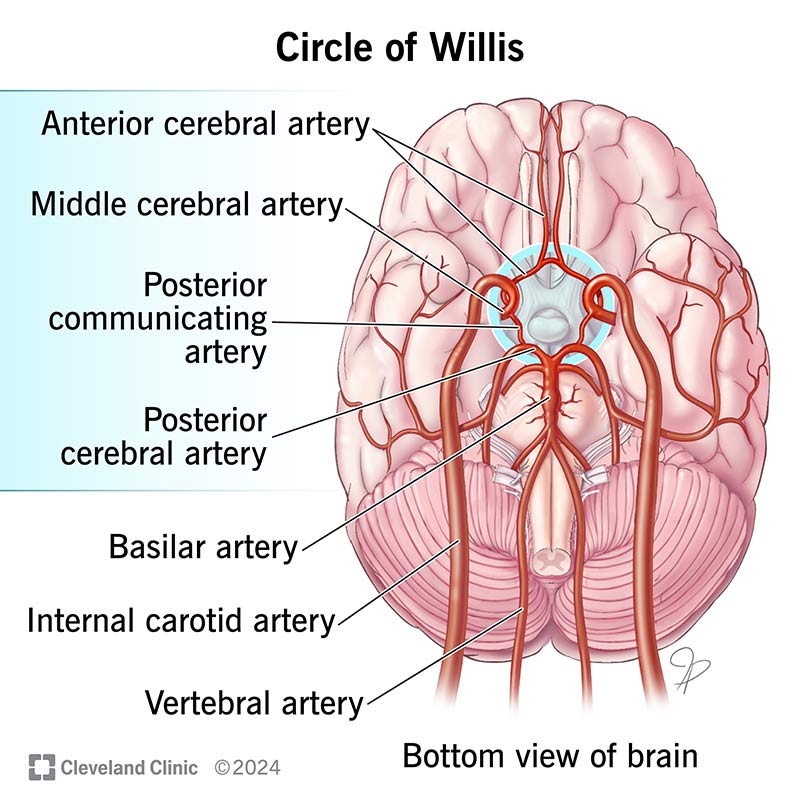The circle of Willis is a loop of arteries at the base of your brain. It functions as the roundabout for the two major arteries that supply blood to your brain. It can play a role in minimizing the effects of certain brain issues, like stroke.
Advertisement
Cleveland Clinic is a non-profit academic medical center. Advertising on our site helps support our mission. We do not endorse non-Cleveland Clinic products or services. Policy

The circle of Willis (CoW) is a ring- or pentagon-shaped structure of arteries located at the base of your brain. It’s where two essential blood flow circulations for your brain connect — the internal carotid artery pathway and the vertebral artery pathway. The internal carotid arteries supply fresh, oxygen-rich blood to most of the front of your brain. The vertebral arteries do the same for most of the back of your brain.
Advertisement
Cleveland Clinic is a non-profit academic medical center. Advertising on our site helps support our mission. We do not endorse non-Cleveland Clinic products or services. Policy
A complete circle of Willis functions as a fail-safe. If one of these two blood vessel pathways becomes damaged, such as from a ruptured brain aneurysm or stroke, the other pathway can still provide blood flow to the affected part of your brain via the CoW.
The circle of Willis gets its name from the anatomist Thomas Willis, who contributed much to our understanding of this anatomical feature today. Other names for the CoW include:
Researchers estimate that a complete circle of Willis exists in less than half of the general population. There are several possible structural variations, which often result in an incomplete circle of Willis.
The most common variations involve changes in the anterior communicating artery (a blood vessel in the front part of the CoW), including:
Even if your CoW is incomplete, you can still be healthy and have healthy brains. However, it may increase the risk of severe effects if you get cerebrovascular disease, like a stroke. There’s nothing you can do to prevent or change an incomplete CoW — it’s just how your blood vessels naturally form during fetal development.
Advertisement
How common is an incomplete circle of Willis?
Researchers believe that an incomplete circle of Willis is common. It’s difficult to know exactly how common it is, though. Only a small percentage of the population gets or needs brain imaging that can evaluate their CoW. Various studies suggest that 50% to 90% of adults have an incomplete CoW.
To understand the function of the circle of Willis, it helps to think of this structure as a traffic roundabout.
Imagine that each of the arteries that make up the CoW is a different road. The two main “highways” that provide the most traffic (blood flow) are the internal carotid artery pathway and the vertebral artery pathway. The other, smaller roads in the CoW form a roundabout for these two highways to connect and exchange traffic.
The CoW helps ensure that if there’s a roadblock or “accident” in one of the main highways (one of your brain’s main arteries), the other highway can help move traffic (blood) to the affected part of your brain. In other words, a complete circle of Willis offers a detour route in the case of a blockage or issue.
If you have a complete circle of Willis, it may prevent you from experiencing severe effects from disease or damage to the arteries of the CoW. These conditions may include:
If you have an incomplete CoW, this roundabout doesn’t work as a fail-safe. It may increase your risk for more severe effects of these cerebrovascular conditions, especially stroke.
The circle of Willis sits at the base of your brain, in the space just outside the brain tissue (subarachnoid space). It surrounds the stalk of your pituitary gland, just below your hypothalamus. The circle of Willis is also near several cranial nerves.
There are a few reasons you may hear about the circle of Willis from your healthcare provider, including if you:
Advertisement
If you have a blockage in your circle of Willis, it’ll likely cause a stroke. But if you have a complete circle of Willis, it may protect you from experiencing severe symptoms of stroke.
Some healthcare providers or medical sources may call moyamoya disease the “circle of Willis syndrome.” Another name for moyamoya disease is “spontaneous occlusion of the circle of Willis.”
The main thing you can do to keep your circle of Willis — and other brain blood vessels — healthy is to manage any risk factors you have for cerebrovascular disease. These risk factors include:
Talk to your healthcare provider about strategies for managing these conditions.
The odds are that most people won’t ever know or hear about their circle of Willis. But your healthcare provider may mention it if you have a brain condition, like an aneurysm or Moyamoya disease. If your provider ever brings up a medical term you don’t understand, don’t hesitate to ask them for clarification. You deserve to know the inner workings of your body.
Advertisement
If you have a neurological condition, you want expert advice. At Cleveland Clinic, we’ll work to create a treatment plan that’s right for you.

Last reviewed on 09/12/2024.
Learn more about the Health Library and our editorial process.